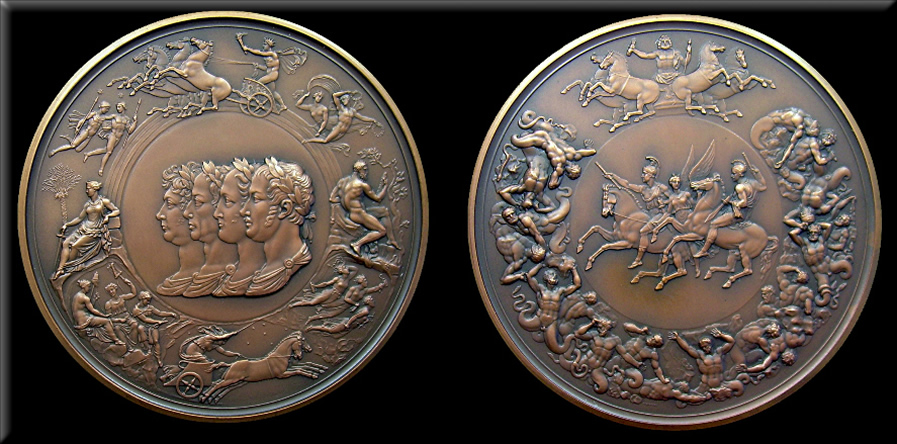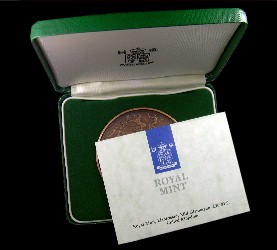Battle of Waterloo (by Benedetto Pistrucci) - 1815


Side 1: Anepigraph |
Side 2: Anepigraph |
BHM 870, Bramsen 2317, d'Essling 1588 |
Mm. 64 - AE copy struck by Royal Mint in 1990, for the 175th anniversary of the battle (Mintage: 5000) |
British Historical Medals - 870 - BATTLE OF WATERLOO |
|
Gutta percha; electrotype, 135 by Pistrucci. |
|
Obv. Conjoined, laureate, draped busts of the four allied sovereigns, the Prince Regent, Francis II of Austria, Alexander I of Russia and Frederick William III of Prussia left. Around , allegorical and mythological allusions to the Treaty of Peace which resulted from the battle of Waterloo. Above, Apollo in a quadriga restoring the day, the rainbow Zephyr and Iris follow the chariot of the sun. Apollo is approaching the constellation of Gemini indicating the month in which the battle took place. In front of the busts of the four sovereigns is the figure of Themis, the protector of the Just. Behind the heads, the figure of Hercules is seated upon a rock above a cavern which suppresses the Furies who are no longer able to leave the Cimmerian caverns. The Fates are shown below the figure of Themis indicating that in future, human actions will be governed by Justice alone. Night, the mother of the Fates receding into darkness below. |
Rev. Two equestrian figures in classical garb with the features of Wellington and Blucher being guided to the conflict by Victory. Around the central figures are many figures symbolising the battle of the giants, they are being struck down by the thunder of Jupiter above. |
Gutta-percha RR; electrotype RR. H 207. BM; RM. |
|
The night of the 16th/17th June saw the harried retreat of Wellington's forces from Quatre Bras to the ridge at Waterloo which the Duke had noted during his inspection of the countryside in the autumn of 1814. The French forces were by this move forced into a frontal attack up the slopes towards a line of fortified farms. The allies numbered some 63,000 men and 156 guns. Late in the morning of the 18th, the French attacked the flanks of the allied position, the Chateau of Hougoumont on the right and the fortified farm of La Haye Sainte in the middle. The allies were outnumbered in both men and guns, and in the face of a fierce artillery barrage, Wellington moved his troops further back over the ridge. Marshal Ney advanced his troops and fully expected to overrun the British lines but such was the fierceness of the allied musket fire that virtually none of the enemy came within bayonet distance. By six o'clock in the evening Ney's efforts were too late, since the Prussians under Field-Marshal von Blucher had arrived and were harassing the flanks of the French troops. After a final, ineffectual attack by Ney, Wellington ordered his cavalry to attack and utterly routed the French; the final pursuit was left to the Prussians who harried the fleeing French throughout the night. By Blucher's timely appearance on the field of battle Wellington's victory was the more complete and the Prussian Field-Marshal became popular in England as a result of it. The City of London conferred the freedom of the city on him and Oxford made him a D.C.L. In 1816 Pistrucci was invited to submit designs for this medal which it was intended to strike in gold and give to the allied sovereigns, their ministers and generals. In August 1819, Treasury authority was given for the work to begin on the preparation of models. Unfortunately, due to a disagreement between Pistrucci and the Master of the Mint over the office of Chief Engraver, the work proceeded very slowly. Pistrucci felt that that office which had been given to William Wyon (who had been performing those duties for some time) should have gone to him. Pistrucci held the office of Chief Medallist to the King for which he received a salary of £300 a year plus another £50 for the instruction of a pupil, but nevertheless felt disgruntled at not being given the more senior position. In 1832 Lord Auckland, the then Master of the Mint, remonstrated with Pistrucci over the delay in producing the medal and Pistrucci requested an assurance that if he completed the medal his connections with the Mint would not be terminated. Lord Auckland would not give such an undertaking and once more the work lapsed. To make matters worse, the additional £50 that Pistrucci had been receiving as part of his salary, was withdrawn. Further queries were raised with Pistrucci in 1842, but again, arguments over the matter of salary delayed work. It was not until August 1844 that agreement over the salary was reached whereby it was raised from £300 to £350 a year and work upon the medal was resumed. In 1849, the Master of the Mint was able to report that the dies were complete, but by this time each of the four allied sovereigns depicted on the obverse (and no doubt many of the other intended recipients of the medal) were dead. Because of the difficulty of hardening dies of the size required to strike the medal, Pistrucci made each die in two parts, an outer ring which fitted around a central die of 71mm. diameter. Each of these was to be hardened separately. Despite his suggestions, the dies were never hardened and only gutta-percha impressions and electrotypes were made. These sometimes occur joined together and the gutta-percha impressions are found in a black japanned metal case. The wax model for the medal is in the Mint Museum in Rome and the dies are in the Royal Mint Museum, London. N.B. Hocking ( Royal Mint Catalogue , vol. II, p. 208) states that the commission for the medal was given to Pistrucci, no suitable designs having been received from members of the Royal Academy. Graham Pollard has pointed out that the design by Flaxman was certainly completed because the diarist Farington records having seen it on 15 August 1815. ( See Royal Academy exhibition catalogue John Flaxman RA. ed. D. Bindman, London, 1979, p. 135 and no.169.) Designs by West are published in R. S. Kraemer, Drawings by Benjamin West , New York, 1975, nos. 101-103, and drawings by Stothard are in the Victoria and Albert Museum (Dyce nos. 850-852). In 1967 Messrs John Pinches Ltd., produced a number of copies of this medal in 22ct. gold, platinum and sterling silver. The size of these copies is 64mm. and each of them is reputed to be either numbered or hallmarked. The author has, however, seen an unmarked sterling silver example; there may possibly be others. |
|